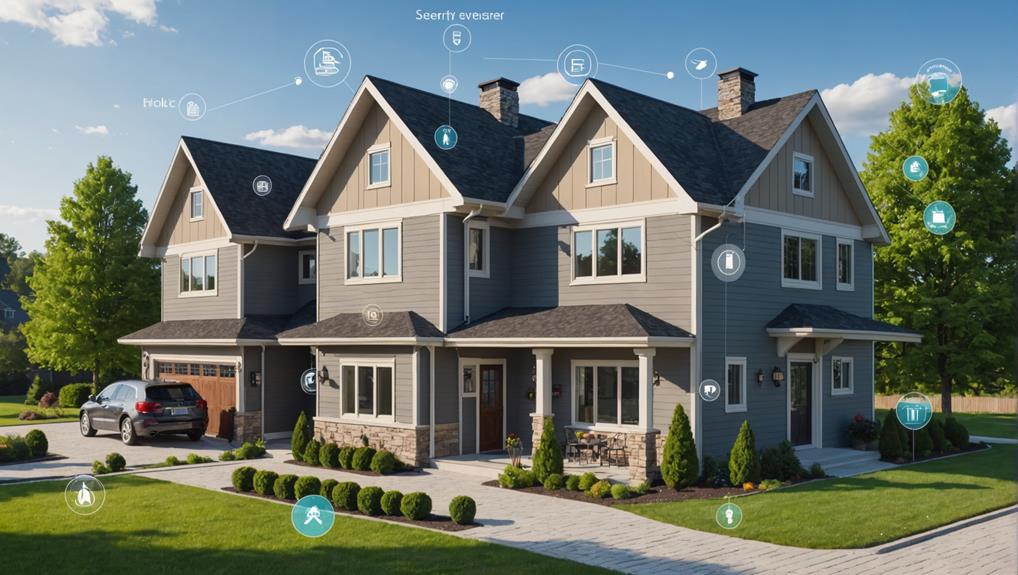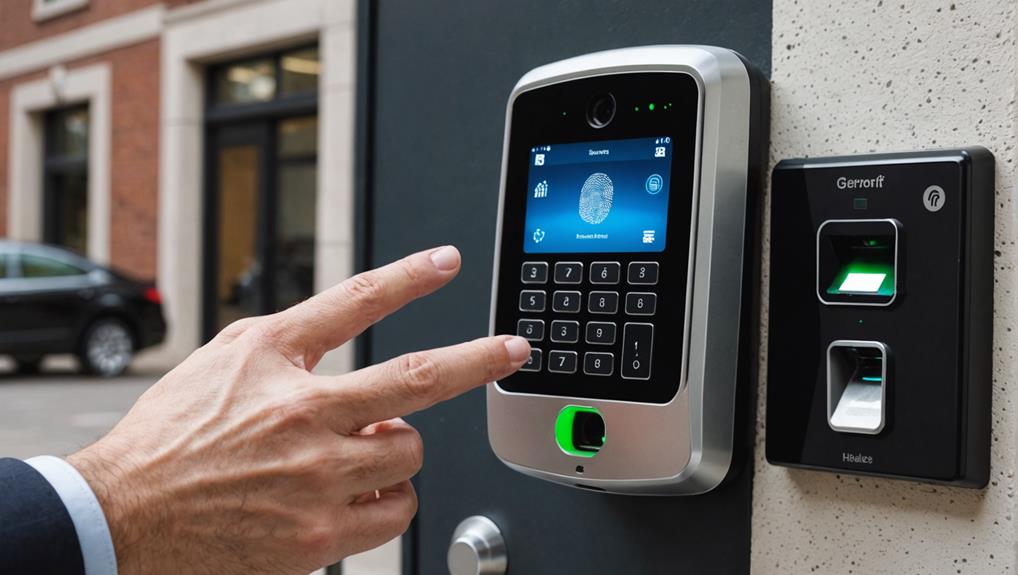In a thorough security plan, alarms and locks are essential for safeguarding your property and assets. Alarms provide immediate alerts during breaches, prompting quick responses. Locks secure access points, restricting entry to authorized individuals. Integrating these elements enhances safety measures by controlling access effectively. Regular maintenance guarantees functionality and compliance with safety standards. By understanding the significance of alarms and locks, you establish a strong foundation for your security protocols.
Key Takeaways
- Alarms provide immediate alerts during security breaches for swift responses.
- Locks secure access points to prevent unauthorized entry.
- Integration of alarms and locks enhances overall security measures.
- Regular maintenance and testing ensure functionality and compliance with safety standards.
- Proper training on alarm systems guarantees efficient emergency reactions.
Security Plan Fundamentals

When developing a security plan, incorporating alarms and locks is essential to creating a robust defense system. These mechanical components are the foundation of any home protection strategy.
By integrating alarms with access control measures, you guarantee that only authorized individuals can access secure areas, enhancing overall safety. Additionally, having a residential security system offers peace of mind and crime prevention, making your home markedly safer.
Remember, regular maintenance and testing of locks and alarm systems are critical. This upkeep guarantees functionality and compliance with safety standards.
Effective alarm systems provide immediate alerts during security breaches, enabling rapid responses from security personnel or law enforcement. To maximize their effectiveness, it's imperative to train staff on using and responding to alarm systems. Proper training guarantees a quick reaction in emergencies, further strengthening your security plan.
Risk Assessment Strategies

Regularly conducting extensive risk evaluations is a foundational step in developing effective security strategies. When evaluating risks for thorough home security, consider specific vulnerabilities such as weak access points and environmental factors that may pose threats. Historical crime data for the area should guide your prioritization of risks to guarantee the most critical vulnerabilities are addressed first. Engage local law enforcement to gain insights into neighborhood crime trends and potential threats, enhancing your security plan.
| Risk Evaluation Strategies | Key Points |
|---|---|
| Identify specific risks | Consider weak access points and environmental threats |
| Evaluate historical crime data | Prioritize risks based on local crime trends |
| Update risk evaluation | Stay aware of emerging threats and adjust security protocols |
| Consider facility activities | Tailor security strategy based on operations within the facility |
| Engage local law enforcement | Gain insights into neighborhood crime trends for better security |
Surveillance System Integration

When integrating surveillance systems with alarms, consider optimizing camera placement for maximum coverage and effectiveness.
To guarantee the best performance, it's vital to follow best practices for both installation and maintenance.
Regular maintenance practices are pivotal to guarantee both systems operate seamlessly and respond promptly to security breaches.
Camera Placement Optimization
For effective surveillance system integration in security plans, optimizing camera placement is a critical aspect to contemplate.
To guarantee complete security systems, it's essential to cover key areas like entrances, exits, and high-traffic zones, minimizing blind spots. Mounting cameras at a height between 8 to 10 feet not only enhances visibility but also deters tampering and vandalism.
Features such as motion detection and night vision greatly improve surveillance effectiveness in varying light conditions. Regular maintenance and angle adjustments are crucial to assure clear and accurate footage capture over time.
Integrating cameras with alarm systems enables real-time alerts during suspicious activities, facilitating swift responses from security personnel.
System Maintenance Practices
To guarantee the seamless operation and effectiveness of your surveillance systems within your security plan, prioritizing system maintenance practices is paramount.
Regular upkeep is critical to ascertain all cameras and recording equipment function correctly. Testing should be conducted at least quarterly to detect any issues promptly.
Integrating surveillance systems with alarms enhances security by enabling simultaneous alerts and real-time monitoring during incidents.
Scheduled software updates are essential to maintain security features and compatibility with other technologies.
Routine audits of surveillance footage storage verify data preservation and compliance with legal retention requirements.
Training staff on system operation and maintenance fosters a culture of security awareness, ascertaining prompt reporting of malfunctions.
Access Control Measures

You must prioritize the efficiency of your locking mechanisms to secure access points effectively.
One way to enhance this is by integrating traditional home alarms with smart technology for improved security and convenience.
Additionally, integrating your access control systems with alarm systems is essential for thorough security coverage.
Locking Mechanism Efficiency
Locking mechanisms play an essential role in maintaining security within any facility. They include key cards, biometric systems, and electronic locks, guaranteeing only authorized personnel access sensitive areas.
To boost efficiency, regularly review and update access permissions to prevent unauthorized entry. Integrating surveillance systems enhances security by monitoring entry points for suspicious activities.
Layering access control by combining physical locks with alarm systems provides added protection against breaches. Remember, routine maintenance and testing are vital to ascertain locking mechanisms function reliably during emergencies.
By prioritizing the efficiency of locking mechanisms, you can fortify your facility's security measures and safeguard against potential threats.
Stay vigilant in managing access control measures to uphold the integrity of your security protocols and protect your facility effectively.
Alarm System Integration
When considering the integration of alarm systems with access control measures, the efficiency and effectiveness of your security network are greatly heightened. This integration allows for real-time monitoring and response to unauthorized access attempts, enhancing security measures.
By combining alarm systems with electronic locks, any breach triggers an immediate alert, prompting a swift response from security personnel. Furthermore, programmable access settings enable automatic arming or disarming based on user permissions, streamlining security operations.
Linking surveillance footage to alarm systems provides valuable video evidence for better incident analysis during alarm activations.
Remember, regular testing and maintenance of both alarm systems and access control measures are essential to guarantee reliability and effectiveness in your all-encompassing security plan.
- Real-time monitoring and response to unauthorized access attempts
- Immediate alerts triggered by breaches for swift security response
- Automatic arming or disarming based on user permissions
- Linking surveillance footage to alarm systems for better incident analysis
Security Personnel Training

Security personnel training plays an essential role in ensuring the effectiveness of security plans within any organization. Regular training sessions are fundamental to equip security staff with the necessary skills to handle emergencies efficiently. This includes providing them with extensive knowledge of alarm systems, enabling quick assessment and response to activations or malfunctions.
Additionally, continuous education on access control protocols is important to keep security personnel updated on the latest technologies and best practices for monitoring entry points. Incorporating training on the fundamental components of residential security systems can also be beneficial, as it broadens the knowledge base of security personnel, making them more versatile in various security scenarios.
Drills and simulations of security breaches or emergencies are instrumental in reinforcing the importance of vigilance and the proper execution of response plans among security personnel. By providing resources and ongoing training on security awareness and reporting suspicious activity, organizations can cultivate a proactive security culture within their ranks.
Ensuring that security personnel are well-trained and prepared enhances the overall security posture of the organization and contributes to a safer environment for all.
Alarm System Functionality

With the exponential increase in technology, alarm systems have become a pivotal element in modern security strategies. These systems offer significant functionalities that enhance overall safety and response capabilities:
- Immediate Alerts: Alarm systems provide instant notifications of unauthorized access or breaches, ensuring swift action to address potential threats.
- Integration with Surveillance: Modern alarms can be linked with surveillance systems for real-time monitoring and coordinated responses, improving incident management. This integration is particularly beneficial in residential settings where both security and convenience are paramount.
- Regular Testing and Maintenance: Ensuring the reliability and compliance of alarm systems through routine checks is essential, especially in public facilities where installation is mandated by state regulations.
- Advanced Features: Features like motion detection and remote notifications enable quick responses to potential dangers, reducing emergency response times.
Additionally, some advanced systems offer environmental monitoring, such as smoke or carbon monoxide detection, further enhancing home safety.
Employee Security Training

Effective employee security training is essential for maintaining a safe and secure work environment. Regular drills on alarm response procedures are critical to guarantee staff can react swiftly during emergencies.
It's important to emphasize reporting suspicious activity and the proper use of security alarms to enhance overall awareness and response capabilities. Additionally, incorporating smoke and carbon monoxide detectors into training can help employees recognize and respond to these hazards, further protecting the workplace.
Educating employees on access control measures, such as securing locks and managing key distribution, helps prevent unauthorized access.
Regular training sessions should provide updates on new security technologies and protocols to keep employees informed about best practices in maintaining a secure environment.
By creating a culture of security awareness within the organization, employees become active participants in the security process, fostering vigilance and a sense of shared responsibility.
Emergency Response Protocols

During emergencies, having well-defined and practiced emergency response protocols is essential for guaranteeing the safety and security of all individuals in the workplace.
The following key elements should be considered in developing effective emergency response protocols:
- Clear Procedures: Guarantee there are clear procedures for activating alarm systems and notifying authorities promptly during a crisis to ensure immediate assistance is dispatched. Understanding the various types of alarm systems can help in selecting the one that best fits your emergency needs.
- Training and Drills: Conduct regular training and drills for staff to prepare them for various scenarios like fire, security breaches, and natural disasters.
- Assigned Roles: Assign specific roles and responsibilities to personnel in the emergency response plan to ensure a coordinated and effective response during an incident.
- Alarm System Integration: Incorporate alarm systems into the emergency response protocol to enhance situational awareness and enable quicker evacuation or lockdown procedures when necessary.
Perimeter Security Implementation

In ensuring thorough security measures, the focus now shifts towards the implementation of robust perimeter security strategies within your workplace.
Effective perimeter security is achieved through access control measures like key cards or biometric systems to restrict entry to authorized personnel. Utilizing smart home security systems can further enhance these efforts by integrating advanced technology for real-time monitoring and alerts.
Regular monitoring of access points with surveillance systems enhances security by providing real-time alerts for suspicious activities. Maintaining clear property boundaries through signage and architectural design deters unauthorized access and delineates public and private areas.
Adequate outdoor lighting around the perimeter eliminates dark areas, markedly improving safety and visibility for employees and visitors. Conducting thorough background checks for new employees and contractors is essential to prevent unsafe individuals from gaining access to the facility.
Frequently Asked Questions
What Are the Five Components of a Comprehensive Security Program in a Hotel?
To guarantee hotel security, you need access control systems for restricted entry, surveillance systems with high-quality cameras, and staff training on security protocols.
Alarm systems are essential for immediate alerts during breaches, integrated with surveillance for quick responses.
Regular risk assessments pinpoint vulnerabilities and inform tailored security measures.
These five components form an all-encompassing security program in a hotel to enhance guest and staff safety.
What Should an Organization's Comprehensive Security Plan Include?
Incorporate access control measures like key cards and biometric systems.
Install high-quality alarm systems that alert authorities during breaches.
Integrate alarms with surveillance for enhanced monitoring.
Provide regular employee training on security and emergency procedures.
Document incidents and analyze footage for investigations.
Implement maintenance schedules for locks and alarms to guarantee reliability and compliance.
What Are the Three Main Components of a Security Plan?
To create a robust security plan, you need physical security measures, operational procedures, and access control systems.
Physical security involves alarms, locks, and surveillance.
Operational procedures include training and emergency protocols.
Access control systems manage who enters secure areas.
When combined, these components bolster security by deterring threats, ensuring preparedness, and controlling access effectively.
Integration of these elements leads to a thorough security approach that safeguards assets and individuals.
Why Are Locks Such an Important Part of Physical Security?
Locks are essential for physical security as they control access to buildings, reducing unauthorized entry risks.
High-security options, like biometric or electronic systems, offer advanced features. Around 70% of burglars exploit unlatched doors or windows, emphasizing the need for reliable locking mechanisms.
Regular maintenance and upgrades prevent vulnerabilities.
Integrating locks with alarms adds an extra layer of security by alerting to unauthorized access attempts.
Conclusion
In summary, alarms and locks play an essential role in a thorough security plan. By incorporating these measures along with surveillance systems, access control, security personnel training, and emergency response protocols, you can effectively protect your property and assets. Remember to continuously assess risks, train employees on security measures, and implement perimeter security to guarantee a well-rounded security strategy. With a strong emphasis on prevention and quick response, you can create a safe and secure environment for your business.









